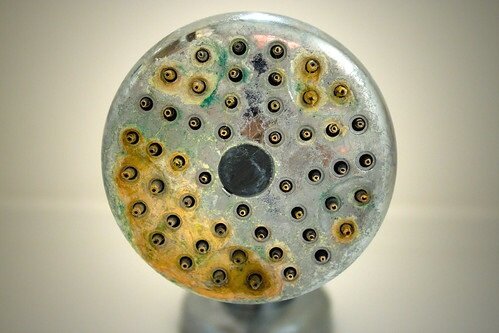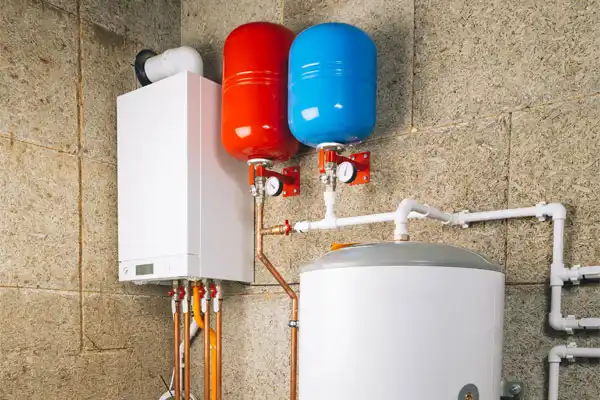Your water heater works hard every day to make sure showers are hot, dishes are clean, and comfort is always within reach. But Southeast Idaho’s hard water and daily use can take a toll. Over time, minerals build up inside your system, efficiency drops, and the risk of leaks or costly breakdowns increases.
The good news? A little care goes a long way. With a few simple maintenance check-ins, you can keep your water heater heating efficiently, lower your utility bills, and avoid those untimely cold-shower surprises. In this blog, we’ll guide you through 6 practical ways you can protect your water heater and keep your hot water steady through a chilly fall, a long Idaho winter, and beyond.
How to Help Your Water Heater Last Longer and Work Smarter
The type of water heater maintenance—and the best way to manage it—depends on your water heater:
- A tanked water heater stores hot water in a large cylinder.
- A tankless water heater provides hot water on demand as it moves through the unit.
Use these 6 tips to keep your water heater—tanked or tankless—running efficiently:
1. Lighten the Load on Your Water Heater
Even in September, your water heater works daily—powering showers, dishes, laundry, and more. The heavier the demand, the harder the system works, which can shorten its lifespan.
Here are some ways to ease the burden:
- Stagger high-demand tasks like showers, laundry, and dishes.
- Track peak usage and spread out chores when possible.
- Keep up with routine maintenance like flushing tanks and checking valves.
- Consider upgrades like larger tanks or high-capacity tankless models if your household has grown.
By spreading out tasks and paying attention to usage, your water heater won’t be pushed to the breaking point.
How This Helps Your Home: Fewer stress points on your water heater mean more reliable hot water and longer system life.
2. Stay Ahead of Mineral Buildup with Water Heater Maintenance

Southeast Idaho water ranks as moderately hard, meaning it naturally contains high levels of calcium and magnesium. Over time, these minerals can build up inside a water heater tank or coat a tankless unit’s heat exchanger, reducing efficiency and putting extra strain on your system.
Here’s how you can protect your tanked or tankless water heater from mineral buildup:
Tanked Water Heater and Water Heater Maintenance
In tanked water heaters, minerals settle at the bottom as sediment, which makes heating less efficient and can eventually damage the tank lining. To help prevent corrosion, these tanks have an anode rod—a metal rod made of magnesium, aluminum, or zinc that attracts corrosive elements to itself, rather than the tank. Because the anode rod gradually wears down, it typically needs to be replaced every 3–5 years to keep the tank protected.
Flushing a tanked water heater drains the tank and rinses out sediment. Doing this at least once a year keeps the system heating efficiently and protects both the tank and the anode rod. In areas with hard water, you may benefit from flushing your tank twice a year.
Tankless Water Heater and Water Heater Maintenance
Since tankless water heaters don’t store water, the hard minerals instead coat the heat exchanger, which slows heat transfer and overworks the unit.
Descaling is a process that uses a specialized cleaning solution to clear and dissolve this mineral buildup. It’s typically recommended as annual maintenance. Although if your home is in an area with very hard water, some technicians recommend descaling every 6–9 months. Always check with your technician to determine the ideal schedule for your unit.
Tip: Consider a Water Softener
A water softener removes hard minerals before they reach your water heater, reducing sediment in tanked units and scale on tankless heat exchangers. Most systems use ion exchange, replacing calcium and magnesium with sodium or potassium ions. This protects your pipes, plumbing system, and water heater from hard water damage and mineral buildup. Talk to your technician to see if a water softener would be a good solution for your home.
How This Helps Your Home: Routine flushing /descaling via a water heater tune-up can keep your heater running smoothly and reduce the risk of early replacement. Pairing these maintenance steps with a water softener, if appropriate for your home, provides an extra layer of protection against hard water buildup and helps keep your system performing at its best.
3. Set the Right Temperature
Most households in Idaho are well-served by a water heater set at 120°F. It’s hot enough for cleaning and comfort, but low enough to reduce the risk of scalding and minimize energy waste.
Here’s why setting the right temperature matters:
- Too high: Wastes energy and increases buildup.
- Too low: Leaves showers lukewarm and dishes less sanitized.
- Annual tune-ups include checking and adjusting temperature settings.
That simple adjustment balances safety, comfort, and cost all year long. At your next water heater tune-up, ask your technician to check and adjust your temperature settings.
How This Helps Your Home: The right temperature setting can conserve energy while maintaining enjoyable hot water at a safe and comfortable temperature.
4. Catch Water Heater Issues Early
Most breakdowns don’t come out of nowhere—they start with small warning signs. The trick is noticing them before you’re left with a cold shower.
Watch for these red flags:
- Fluctuating water temperature
- Longer wait times for hot water
- Popping or rumbling sounds from a tank
- Reduced water pressure at hot taps
If you catch these signs early, you can schedule service or any necessary water heater repairs before winter rushes in.
How This Helps Your Home: Early fixes prevent costly repairs and keep hot water reliable when you need it most.
5. Match Water Heater Maintenance to Your System Type
Not all water heaters need the same kind of care. Tanked and tankless units both heat your water, but they operate differently and wear down in different ways. Understanding which maintenance tasks apply to your system ensures the right care is done on the proper schedule.
Some tasks—like inspecting the system for leaks, performing a full diagnostic, or replacing certain components—should be done by an expert plumber, while simpler tasks, like flushing a tank or cleaning filters, can be handled safely at home. Following the right mix of DIY and professional maintenance helps protect your water heater’s lifespan and keeps it running efficiently.
To make it easier, here’s a breakdown of routine care for both tanked and tankless water heaters:
Tanked Water Heater (average lifespan: 8–12 years):
- DIY-friendly: Flush the tank at least once a year to clear sediment buildup, and test the pressure relief valve to make sure it’s working.
- Professional-only: During your annual tune-up, an expert technician will also flush, inspect, and adjust the system to ensure it heats safely and efficiently. Every 2–3 years, have the anode rod inspected and replaced if needed. Schedule extra maintenance if you notice reduced flow, unusual noises, or other signs of wear.
Tankless Water Heater (average lifespan: 15–20 years):
- DIY–friendly: Regularly clean the air filter to maintain proper airflow.
- Professional-only: Schedule annual descaling to remove mineral buildup from the heat exchanger, plus diagnostics and a full tune-up to catch problems early. Extra maintenance may be needed if the water flow drops or there are unusual noises.
Each type of water heater has its own specific maintenance needs, and following the right maintenance plan helps you get the most years of use out of your system. With regular service, many units last until or well beyond their average lifespan—saving you the cost and hassle of an early replacement. And because Southeast Idaho’s hard water accelerates wear, these check-ins are even more important for local families.
How This Helps Your Home: System-specific water heater maintenance means better efficiency, fewer breakdowns, and hot water you can count on all year.
6. Adjust Settings When You’re Away
Your water heater doesn’t need to work full-time while you’re away. On most tanked water heaters, the vacation mode setting keeps the pilot light on but lowers the water temperature, so the tank isn’t constantly reheating water no one’s using. With a tankless system, vacation mode (or simply turning the unit off) does the same thing by pausing the burner until you’re back.
It’s an easy way to cut down on energy waste and reduce wear and tear, while still coming home to a system that’s ready to start heating water again.
Here’s how to prepare your water heater before leaving:
- Switch tanked heaters to vacation mode or lower the temperature.
- Power down or adjust tankless systems.
- Have a technician walk you through model-specific steps during your tune-up.
When you return, your system will be ready to deliver hot water without having wasted energy while you were gone.
How This Helps Your Home: Save money and reduce wear while you’re away—without sacrificing comfort when you get back.
Why Fall Is a Great Time for a Water Heater Check-In
Fall is a season of transition. Days can climb into the 70s or even 80s, while mornings dip into the 40s. It’s also when hot water use often spikes—kids are back in school, routines get busier, and cooler weather means longer showers and heavier laundry loads.
Here’s why scheduling a water heater check-in now makes sense:
- Avoid winter surprises: Spot problems before freezing nights push your system harder.
- Handle sediment and scale buildup early: Idaho’s hard water can quickly reduce efficiency if left unchecked.
- Stay efficient as bills rise: Fall is the start of higher energy use, so every bit of savings helps.
- Get ahead of the rush: Local plumbers get busier as cold weather sets in—fall offers more flexibility.
By tackling small tasks now, you’ll head into winter with steady hot water and peace of mind.
Expert Water Heater Maintenance and Service in Southeast Idaho
Even the best water heater can’t run reliably without care. Skipping maintenance or ignoring small issues can mean higher bills, shorter system life, and an untimely breakdown. That’s why fall is the perfect time to check in on your system and get ahead of the heating season.
At Advanced Home Services, we know the unique challenges of Southeast Idaho’s water and climate. From hard water scale to seasonal temperature swings, our expert plumbers can tailor water heater care to your home’s needs. Call Advanced Home Services today to schedule your water heater service, so you can have hot water comfort at the turn of a tap.

